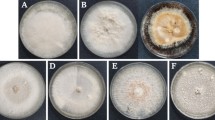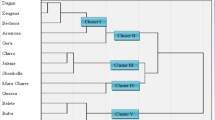Summary
The majority of isolates ofFusarium avenaceum caused dry rot on potato tubers; many were as pathogenic asF. coeruleum. Pathogenicity ofF. avenaceum was not related to the plant species from which the isolates originated. Tubers of potato cv. Cara were more susceptible than those of cvs Romano or Maris Piper. Temperature (5–15° C) had no effect on lesion depth but lesions tended to be slightly wider at the lowest temperature. Two isolates (of 61) from wheat and white lupin had a moderate level of resistance to thiabendazole. The results are discussed in relation to the control of dry rot in stored potato tubers.
Similar content being viewed by others
References
Bång, U., 1989. Effect of haulm treatment and harvest time on incidence of tuber rots of potato (Solanum tuberosum L.) after standard wounding and on frequency of stem lesions caused byPhoma foveata Foister.Potato Research 32: 101–112.
Brenchley, G.H. & H.J. Wilcox, 1979. Potato diseases. HMSO, London, 106 pp.
Carnegie, S.F., A.D. Ruthven, D.A. Lindsay & T.D. Hall, 1990. Effects of fungicides applied to seed potato tubers at harvest or after grading on fungal storage diseases and plant development.Annals of Applied Biology 116: 61–72.
Chelkowski, J., 1989. Toxigenicity ofFusarium species causing dry rot of potato tubers. In: J. Chelkowski (Ed.),Fusarium: mycotoxins, taxonomy and pathogenicity. Elsevier, Amsterdam, pp. 435–440.
Chroszewski, P.P., 1985. [Species composition of fungi on potato tubers with dry rot symptoms].Ziemniak, 1985 (Instytut Ziemniaka, Bonin, Poland): 105–116.
Desjardins, A.E., E.A. Christ-Harned, S.P. McCormick & G.A. Secor, 1993. Population structure and genetic analysis of field resistance to thiabendazole inGibberella pulicaris from potato tubers.Phytopathology 83: 164–170.
Dorozhkin, N.A., V.I. Bilaï, S.I. Bel'skaya, I.A. Ellanskaya, T.P. Alekseeva & L.M. Novikova, 1984. [Fusarium fungi on potato in Belorussia].Mikologiya i Fitopatologiya 18: 326–330.
Gindrat, D., 1984a. La pourriture des pommes de terre lors de la conservation. I. Symptômes et flore mycologique.Revue Suisse d'Agriculture 16: 279–284.
Gindrat, D., 1984b. La pourriture des pommes de terre lors de la conservation. II. Développement des lésions en fonction de l'espèce parasite et de la température.Revue Suisse d'Agriculture 16: 313–318.
Gindrat, D. & R. Pilloud, 1985. La pourriture fongique des tubercules de pomme de terre en atmosphère contrôléc.Potato Research 28: 153–160.
Hansen, L.E., S.J. Schwager & R. Loria, 1996. Sensitivity to thiabendazole inFusarium species associated with dry rot of potato.Phytopathology 86: 378–384.
Hide, G.A., R.L. Griffith & M.J. Adams, 1977. Methods of measuring the prevalence ofPhoma exigua on potatoes and in soil.Annals of Applied Biology 87: 7–15.
Hide, G.A., P.J. Read & S.M. Hall, 1992. Resistance to thiabendazole inFusarium species isolated from potato tubers affected by dry rot.Plant Pathology 41: 745–748.
Hooker, W.J. (Ed.). 1981. Compendium of potato diseases. American Phytopathological Society. St Paul, pp. 125.
Logrieco, A., S. Frisullo & A. Bottalico, 1987. Specie de Fusarium associate a marciumi di patate da “seme” in Italia meridionale e relativi saggi di patogenicitia e tossicita.Informatore Fitopatologico 37(4): 33–36.
McKee, R.K., 1954. Dry-rot disease of the potato. VIII. A study of the pathogenicity ofFusarium caeruleum (Lib.) Sacc. andFusarium avenaceum (Fr.) Sacc.Annals of Applied Biology 41: 417–434.
Nirenberg, H.I., 1976. Untersuchungen über die morphologische und biologische Differenzierung in derFusarium-Sektion Liseola.Mitteilungen aus der Biologischen Bundesanstalt für Land-und Forstwirtschaft, Berlin-Dahlem 169: 1–117.
Šavor, J., 1984. [Fusarium species as pathogens of dry rot of potato in Slovenia].Zastita Bilja 35: 117–125.
Seppänen, E., 1982. Fusariums of the potato in Finland. V. Further investigations into the growth optima ofFusarium species in potato tubers.Annales Agriculturae Fenniae 21: 162–168.
Seppänen, E., 1983a. Fusariums of the potato in Finland. VI. Varietal tuber resistance toFusarium species.Annales Agriculturae Fenniae 22: 8–17.
Seppänen, E., 1983b. Fusariums of the potato in Finland. VIII. Occurrence of the pathogens causing potato dry rot and gangrene.Annales Agriculturae Fenniae 22: 115–119.
Author information
Authors and Affiliations
Rights and permissions
About this article
Cite this article
Aprasad, K.S., Bateman, G.L. & Read, P.J. Variation in pathogenicity on potato tubers and sensitivity to thiabendazole of the dry rot fungusFusarium avenaceum . Potato Res 40, 357–365 (1997). https://doi.org/10.1007/BF02357994
Accepted:
Issue Date:
DOI: https://doi.org/10.1007/BF02357994




